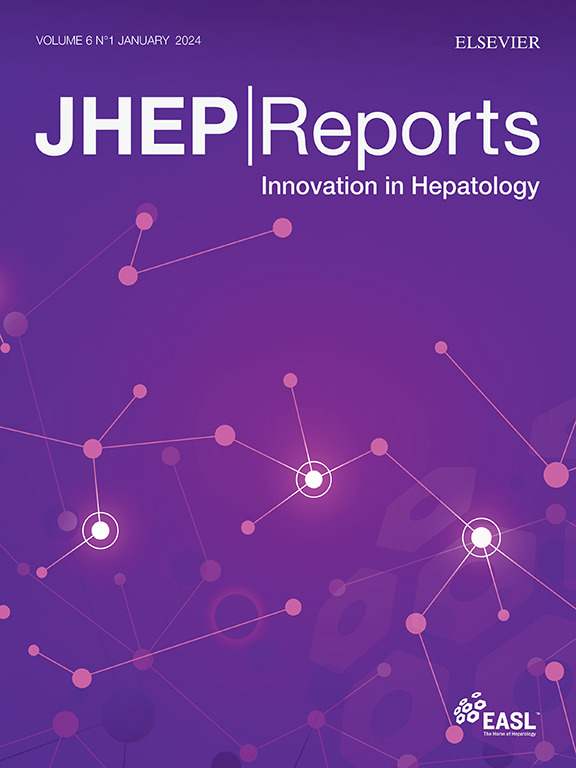ai -肝硬化-心电图(ACE)评分用于预测失代偿和肝脏预后
IF 9.5
1区 医学
Q1 GASTROENTEROLOGY & HEPATOLOGY
引用次数: 0
摘要
背景,目的肝硬化患者疾病严重程度和预后的准确预测具有挑战性。我们评估了基于深度学习的ai -肝硬化-心电图(ACE)评分是否可以检测肝功能失代偿并预测肝硬化的临床结局。方法:我们分析了来自Mayo Clinic回顾性队列的472例患者的2166例心电图,来自Mayo移植前瞻性队列的420例患者,以及来自Clínic de Barcelona医院的外部验证队列的341例患者。ACE评分的评估采用了失代偿检测的接受者-操作特征分析和结果预测的竞争风险Cox回归。结果ACE评分对肝功能失代偿的检测准确率较高(曲线下面积0.933,95% CI: 0.923 ~ 0.942),灵敏度为88.0%,特异性为84.3%,最佳阈值为0.25。在多变量分析中,ACE评分每增加0.1分与肝脏相关死亡风险增加独立相关(风险比[HR] 1.44, 95% CI 1.32-1.58, p <0.001)。在终末期肝病模型中加入ACE -钠显著提高了所有队列不良结局的预测(c-统计:回顾性队列0.903 vs. 0.844;前瞻性队列0.779 vs. 0.735;外部验证0.744 vs. 0.732;p <0.001)。结论ACE评分能准确识别肝硬化患者的肝功能失代偿,并能独立预测肝硬化患者的肝脏相关预后。这种非侵入性工具增强了当前的预后模型,并可能改善肝硬化管理中的风险分层。影响和意义本研究证明了人工智能在增强肝病预后方面的潜力,解决了肝硬化管理中改善风险分层的关键需求。ai -肝硬化-心电图(ACE)评分来源于广泛使用的心电图,有望作为检测肝失代偿和预测肝脏相关预后的无创工具,这可能会显著影响肝病学的临床决策和资源分配。这些发现对肝病学家、移植外科医生和肝硬化患者尤其重要,因为它们提供了一种新的方法来补充现有的预后模型,如终末期肝病模型。在实践中,ACE评分可以整合到常规临床评估中,以提供更准确的风险预测,潜在地改善干预时机,优化移植清单决策,并最终提高患者的预后。然而,在广泛的临床应用之前,需要在不同人群中进一步验证并与其他已建立的预测因子相结合。本文章由计算机程序翻译,如有差异,请以英文原文为准。

AI-Cirrhosis-ECG (ACE) score for predicting decompensation and liver outcomes
Background & Aims
Accurate prediction of disease severity and prognosis are challenging in patients with cirrhosis. We evaluated whether the deep learning-based AI-Cirrhosis-ECG (ACE) score could detect hepatic decompensation and predict clinical outcomes in cirrhosis.
Methods
We analyzed 2,166 ECGs from 472 patients in a retrospective Mayo Clinic cohort, 420 patients in a prospective Mayo transplant cohort, and 341 patients in an external validation cohort from Hospital Clínic de Barcelona. The ACE score's performance was assessed using receiver-operating characteristic analysis for decompensation detection and competing risks Cox regression for outcome prediction.
Results
The ACE score showed high accuracy in detecting hepatic decompensation (area under the curve 0.933, 95% CI: 0.923–0.942) with 88.0% sensitivity and 84.3% specificity at an optimal threshold of 0.25. In multivariable analysis, each 0.1-point increase in ACE score was independently associated with increased risk of liver-related death (hazard ratio [HR] 1.44, 95% CI 1.32–1.58, p <0.001). Adding ACE to model for end-stage liver disease-sodium significantly improved prediction of adverse outcomes across all cohorts (c-statistics: retrospective cohort 0.903 vs. 0.844; prospective cohort 0.779 vs. 0.735; external validation 0.744 vs. 0.732; all p <0.001).
Conclusions
The ACE score accurately identifies hepatic decompensation and independently predicts liver-related outcomes in cirrhosis. This non-invasive tool enhances current prognostic models and may improve risk stratification in cirrhosis management.
Impact and implications
This study demonstrates the potential of artificial intelligence to enhance prognostication in liver disease, addressing the critical need for improved risk stratification in cirrhosis management. The AI-Cirrhosis-ECG (ACE) score, derived from widely available ECGs, shows promise as a non-invasive tool for detecting hepatic decompensation and predicting liver-related outcomes, which could significantly impact clinical decision-making and resource allocation in hepatology. These findings are particularly important for hepatologists, transplant surgeons, and patients with cirrhosis, as they offer a novel approach to complement existing prognostic models such as model for end-stage liver disease-sodium. In practical terms, the ACE score could be integrated into routine clinical assessments to provide more accurate risk predictions, potentially improving the timing of interventions, optimizing transplant listing decisions, and ultimately enhancing patient outcomes. However, further validation in diverse populations and integration with other established predictors is necessary before widespread clinical implementation.
求助全文
通过发布文献求助,成功后即可免费获取论文全文。
去求助
来源期刊

JHEP Reports
GASTROENTEROLOGY & HEPATOLOGY-
CiteScore
12.40
自引率
2.40%
发文量
161
审稿时长
36 days
期刊介绍:
JHEP Reports is an open access journal that is affiliated with the European Association for the Study of the Liver (EASL). It serves as a companion journal to the highly respected Journal of Hepatology.
The primary objective of JHEP Reports is to publish original papers and reviews that contribute to the advancement of knowledge in the field of liver diseases. The journal covers a wide range of topics, including basic, translational, and clinical research. It also focuses on global issues in hepatology, with particular emphasis on areas such as clinical trials, novel diagnostics, precision medicine and therapeutics, cancer research, cellular and molecular studies, artificial intelligence, microbiome research, epidemiology, and cutting-edge technologies.
In summary, JHEP Reports is dedicated to promoting scientific discoveries and innovations in liver diseases through the publication of high-quality research papers and reviews covering various aspects of hepatology.
 求助内容:
求助内容: 应助结果提醒方式:
应助结果提醒方式:


